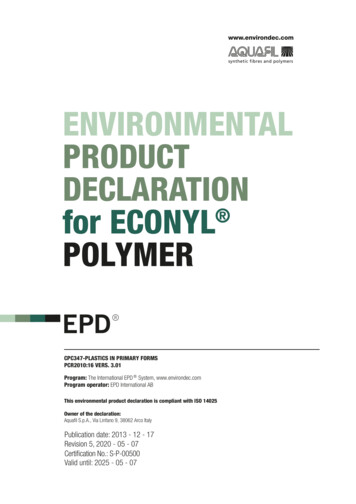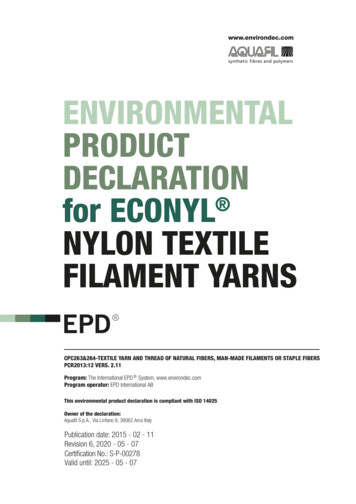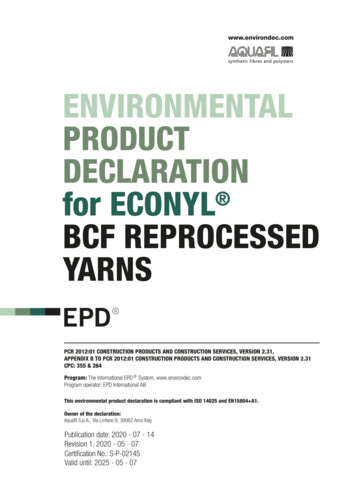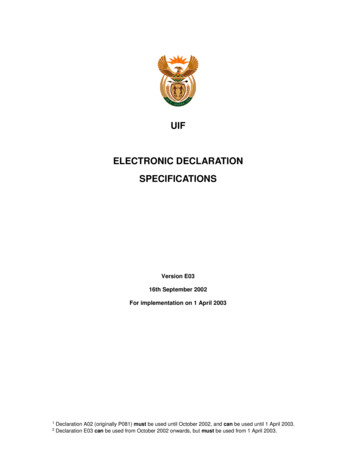
Transcription
ENVIRONMENTALPRODUCTDECLARATION for ECONYLPOLYMERCPC347-PLASTICS IN PRIMARY FORMSPCR2010:16 VERS. 3.01Program: The International EPD System, www.environdec.comProgram operator: EPD International ABThis environmental product declaration is compliant with ISO 14025Owner of the declaration:Aquafil S.p.A., Via Linfano 9, 38062 Arco ItalyPublication date: 2013 - 12 - 17Revision 5, 2020 - 05 - 07Certification No.: S-P-00500Valid until: 2025 - 05 - 07
EPD for Aquafil ECONYL PolymerCOMPANYAND PRODUCTRelated informationRev. 5, 2020 - 05 - 07
EPD for Aquafil ECONYL PolymerRev. 5, 2020 - 05 - 07THE COMPANYAquafil Group history began in 1969, when the Bonazzi family built the firstmanufacturing plant in Arco (Trentino Alto Adige region, Italy). In 1970, theGroup began the polymerization and production of polyamide 6 at this facility,which started Aquafil’s market share acquisition in the BCF yarn sector(polyamide yarn for textile flooring). During the ‘80s, significant investmentsallowed a consolidation and diversification of the Group’s activities. The mostsignificant diversification of the Group's operation occurred in 1995 when theAquafil Group finalized the first privatization of a public company in the newlyborn Republic of Slovenia. This acquisition allowed Aquafil to start its NylonTextile Filament (NTF) product area.Meanwhile, the Group continued to widen its product offering by openingseveral production plants in Europe and entering (with its “Polyamide productspriority focus” always in mind) the Engineering Plastics business to supplyengineering plastics to the automotive, electronics and construction industries.At the same time, the Group started its internationalization process with thecreation of Aquafil USA, based in Cartersville, Georgia (USA).Between 2000 and 2010, the Group expanded its presence in all three keymarkets where it was operating (carpet yarn, textile yarn and engineeringplastics), gradually becoming a global leader in the manufacturing of Polyamide6 fibers. In 2005, a manufacturing facility was established in Thailand forprocessing and marketing BCF products for the carpet industry in the Asianarea. In 2009, a new manufacturing facility was built in China to assist in theever-growing Asian market. In 2013, the Group sold the Engineering Plasticsdivision to DOMO and acquired DOMO's BCF business Xentrys.In 2007 the company started the development of a visionary project aligned withits manufacturing and market growth focus. Driven by a genuine concern for theenvironment, resources and investments were dedicated to the design andconstruction of the ECONYL Regeneration Plant (the recycling of pre- andpost-consumer Polyamide 6 waste material), which was launched in 2011. As of2019, the Group operates 16 manufacturing plants worldwide with more than2,900 employees, in eight countries (Italy, Slovenia, Croatia, Germany, UnitedKingdom, USA, Thailand and China) on three continents (Europe, North Americaand Asia).3
EPD for Aquafil ECONYL PolymerRev. 5, 2020 - 05 - 07IT OPERATES 2 DIFFERENT PRODUCT AREAS: BCFCarpet yarn for the flooring market NTFSpecial yarns for sportswear and fashion applications In 2008, during the engineering and design phase of Aquafil's ECONYLpRegeneration System, a third operating unit was created - Energy & Recycling.This Energy & Recycling operational unit is dedicated to the promotion ofsustainability and environmental issues. It has a transverse nature in respect tothe other product areas, providing solutions and innovative technologies in thearea of energy, recycling and the promotion of the culture of sustainability bothinside and outside of the Group.4
EPD for Aquafil ECONYL PolymerRev. 5, 2020 - 05 - 07PROGRAM INFORMATIONPROGRAM OPERATOREPD international AB: Valhallavägen 81, SE-114 27 Stockholm Sweden;E-mail: info@environdec.comCOMPARABILITYEPDs within the same product category but from different programs may not becomparable.OWNERSHIPThe EPD owner has the sole ownership, liability, and responsibility for this EPD.VERIFICATION INFORMATIONCPC347- Plastics in primary formsPCR2010:16 vers. 3.01PRC review was conducted by: Technical Committee of the International EPD SystemIndependent third-party verification of the declaration and data, according toISO 14025:2010:EPD process certificationX EPD verificationThird party verifier:Bureau Veritas, accredited by SWEDACwww.bureauveritas.comProcedure for follow-up data during EPD validity involves third-party verifier:XYESNO5
EPD for Aquafil ECONYL Polymer3Rev. 5, 2020 - 05 - 07PRODUCT INFORMATIONOWNER OF THE EPDAquafil S.p.A., Via Linfano 9, 38062 Arco, ItalyP: 39 0464 581111E-mail: info@aquafil.comTo get more information about this environmental declaration or about Aquafilactivities please contact:Lucija AleksicE- mail: lucija.aleksic@aquafil.comT. 386 (0)40 193499LCA performed by:Jaka JelencE-mail: jaka.jelenc@aquafil.comT. 386 (0)30 646255DESCRIPTION OF THE PRODUCTThis EPD refers to a PA6 polymer of 100% recycled with post-consumer andpost-industrial recycled (certified by independent third party DNV18590-2008-PC-ITA-DNV), which is used in several sectors such as apparel,residential, automotive, fashion, sportswear, electrical, building constructionand technical applications.This declaration refers to two polymers ECONYL polymers 2,4 viscosity; produced in AquafilSLO plant (SloveniaLjubljana) ECONYL polymers 2,7 viscosity; produced in Aquafil plant (Italy Arco andSlovenia Ljubljana)6
EPD for Aquafil ECONYL PolymerRev. 5, 2020 - 05 - 07IDENTIFICATION OF THE PRODUCT ACCORDING TO THE UN CPC SCHEME347 – Plastics in primary forms.PRODUCTION SITES INVOLVED IN EPD AquafilSLO d.o.o. - Ljubljana (Letališka cesta 15, 1000 Ljubljana,Slovenia) process E & F AquafilSLO d.o.o. - Ajdovščina (Tovarniška cesta 15, 5270 Ajdovščina,Slovenia) process I Aquafil S.p.A. (Via Linfano 9, 38062 Arco, Italy) process A Aquafil Carpet Recycling (ACR#1) Phoenix (3555 W. Washington street, 85009Phoenix, USA) process S Production country: Italy, SloveniaISO XXXXXXXXISO 9001 : 2015ISO 14001 : 2015OHSAS 18001 : 2007AquafilS.p.A.ACR#1PhoenixPRODUCT CHARACTERISTICSA. Product information on ECONYL polymer 2,4 viscosity: Trade name: ECONYL polymer 2,4 viscosity ISO code: PA6 IUPAC name: poly (hexano-6-lactam) CAS number: 25038-54-4 GHS classification: not dangerousTEST METHODISO 1183VALUE1,14 g/ccMelt flow rateISO 113359,1 cc/10 Tensile strength at yieldISO 52778,48 MPaISO 113572260CISO 751800C (0,45 MPa)TECHNICAL SPECIFICATIONDensityGlass transition temperature for amorphous polymersDeflection temperature under load7
EPD for Aquafil ECONYL PolymerRev. 5, 2020 - 05 - 07B. Product information on ECONYL polymer 2,7 viscosity: Trade name: ECONYL polymer 2,7 viscosity ISO code: PA6 IUPAC name: poly (hexano-6-lactam) CAS number: 25038-54-4 GHS classification: not dangerousTEST METHODISO 1183VALUE1,14 g/ccMelt flow rateISO 113333,6 cc/10 Mechanical properties: TensileISO 52775,99 MPaISO 113572220CISO 751800C (0,45 MPa)TECHNICAL SPECIFICATIONDensityGlass transition temperature for amorphous polymersDeflection temperature under loadGEOGRAPHICAL SCOPE OF THE EPDGlobal.DECLARED UNITDeclared unit is 1 kg of granules delivered.REFERENCE SERVICE LIFEThis EPD does not indicate RSL.DATA COLLECTIONLife cycle assessment primary data of processes owned by Aquafil groupwere collected from period of January 2019 to December 2019.BACKGROUND DATA AND METHODAll the background data relevant for modelling were taken from Gabidatabase – service pack 40, (update 2020). CML2001, January 2016assesment method is used.8
EPD for Aquafil ECONYL PolymerRev. 5, 2020 - 05 - 07SYSTEM BOUNDARIESUPSTREAMExtraction of non-renewable resourcesInorganic synthesisproductionCrude oil refineryprocessesMaterial storage and handlingWaste collectionUSA fluff / granulate production (S)PA6 Fishing netsWaste pretreatment - Ajdovščina (I)Depolymerization (E)COREPolymerization (A&F)Extrusion (A&F)Pelletising (A&F)Washing (A&F)Drying (A&F)DOWNSTREAMStorage (A&F)TRANSPORTATIONUse phaseProduct packaging and end of lifePROCESSES RELATED TO THEPRODUCTION OF AUXILIARY CHEMICALS9PROCESSESINCLUDED IN EPDPROCESSES NOTINCLUDED IN EPD
EPD for Aquafil ECONYL PolymerRev. 5, 2020 - 05 - 07CONSIDERED LIFE CYCLE STAGESUpstream processes include: extraction of non-renewable resources additives and auxiliary’s production all relevant transportationAll energetic input flows (electricity, heating fuels, steam.) and waterconsumption to the upstream processes are considered. All emissions to air,water and soil and treatment of waste and wastewater generated are consideredas well.The Core Process analysis considers resources, as well as electricity and fuels,transportation of materials, emissions and waste that go into or are given offduring the production of ECONYL polymer.Transportation of all input materials is included.Core processes include: transportation of all input materials; waste materials that are entering the pretreatment plant and areconstituted of three main types of waste:A. PA6 fishing nets collection;B. PA6 carpets, fluff or granules;C. Oligomers and other plastics waste generated by polymerindustries.Depending on the type and shape of waste, it can be cleaned, sorted, grinded,washed, granulated, and/or pelletized.All waste material is characterized with the specific feedstock energy enteringthe system and the processes are described by means of energy use andemissions. ECONYL plant operation;A. washing (when necessary);B. depolymerization (where specific mix of waste is transformed backinto secondary raw material – caprolactam);C. purification of caprolactam. polymer production;A. polymerization;B. extrusion;C. pelletizing;D. washing;E. drying.10
EPD for Aquafil ECONYL Polymer Rev. 5, 2020 - 05 - 07storage and packing of polymer.All energetic input flows (electricity, heating fuels, steam.) and waterconsumption to the upstream processes are considered. All emissions to air,water and soil and treatment of waste and wastewater generated are consideredas well.Downstream processes include transportation to average retailer / distributionplatform: 300 km by truck.Use phase and end of life of product are not included.CUT OFF CRITERIAIn general, Life Cycle Inventory data for a minimum of 99% of totalinflows (mass and energy) to the upstream and core module is included.All energy inflows are considered in the study.Primary packaging material was considered: polymerization process: tank truck.11
EPD for Aquafil ECONYL Polymer4Rev. 5, 2020 - 05 - 07CONTENT DECLARATIONMATERIALPolyamide 6% OF MATERIAL BY WEIGHT100OF WHICH RECYCLED %CAS NUMBER10025038-54-4ECONYL polymers do not contain any materials / substances hazardous to healthand the environment (carcinogenic, mutagenic or toxic to reproduction, allergic,PBT, vPvB) or substances of very high concern (SVHC), according to Regulation(EC) No 1907/2006 and Regulation (EC) No 1272/2008.ECONYL polymers are produced out of 100 % recycled PA6 polymer, withpost-consumer and post-industrial recycled content certified by independent thirdparty DNV 18590-2008-PC-ITA-DNV.12
EPD for Aquafil ECONYL Polymer5Rev. 5, 2020 - 05 - 07ENVIRONMENTAL PERFORMANCEAll the data are given for an average ECONYL polymer, which is constituted of47% by mass of ECONYL polymer produced in AquafilSLO - Ljubljana and 53%by mass of ECONYL polymer produced in Aquafil Arco and is representing theproduction ratio of 2019.POTENTIAL ENVIRONMENTAL IMPACTSIMPACT CATEGORIESUPSTREAMCOREDOWNSTREAMTOTALGWP biogenic*kg CO2 eq-7,72E-049,69E-03-1,00E-048,82E-03GWP fossil*kg CO2 eq0,150,770,020,94GWP Land use*kg CO2 eq1,65E-042,15E-031,59E-042,48E-03GWP total*kg CO2 eq0,140,780,020,95Acidification Potentialskg SO2 eq1,18E-036,11E-038,77E-057,37E-03Photochemical Ozone Creation P.kg C2H2 eq6,96E-054,79E-048,14E-065,57E-04Eutrophication Potentialskg PO4 eq5,78E-051,62E-032,16E-051,70E-03Abiotic Depletion Potential - elementskg Sb eq2,07E-072,13E-071,62E-094,21E-07Abiotic Depletion Potential - fossil fuelMJ net calorific value3,097,500,2610,85m³ eq0,730,421,76E-041,15Water scarcity potentialTotals may not match, because of rounded dataUSE OF RESOURCESUNITUPSTREAMCOREDOWNSTREAMTOTALUse as energy carrierMJ, net calorific value0,1916,540,0116,74Use as raw materialsMJ, net calorific value0000TOTALMJ, net calorific value0,1916,540,0116,74Use as energy carrierMJ, net calorific value3,207,570,2611,04Use as raw materialsMJ, net calorific value034,20034,20TOTALMJ, net calorific value3,2041,770,2645,24PARAMETERPrimary energyresources renewablePrimary energyresources - nonrenewable13
EPD for Aquafil ECONYL PolymerUNITPARAMETERRev. 5, 2020 - 05 - 07UPSTREAMCOREDOWNSTREAMTOTALSecondary materialkg01,5301,53Renewable secondary fuelsMJ, net calorific value0000Non-renewable secondary fuelsMJ, net calorific value0000UNITUPSTREAMCOREDOWNSTREAMTOTALNet use of fresh waterm³0,020,011,71E-050,03Agricultural land use for renewablematerial productionm²0000PARAMETERTotals may not match, because of rounded dataWASTE PRODUCTION AND OUTPUT FLOWSUNITUPSTREAMCOREDOWNSTREAMTOTALHazardous waste rdous waste disposedkg0,270,034,02E-050,30Radioactive waste REAMCOREDOWNSTREAMTOTALComponents for re-usekg0000Materials for recyclingkg7,68E-080,1600,16Materials for energy recoverykg0000Exported energy, electricitykg00,5500,55Exported energy, thermalKg00,9900,99PARAMETERPARAMETERTotals may not match, because of rounded data14
EPD for Aquafil ECONYL PolymerRev. 5, 2020 - 05 - 07OTHER ENVIRONMENTAL REAMTOTALMJ034,2034,2%0000GROSS ENERGY REQUIREMENTPARAMETEREnergy content of product% of bio-basedTotals may not match, because of rounded dataTECHNOLOGYAPPLIED chemical depolymerization and subsequentpurification step.PERCENT OF RECOVERED PA6 FRACTION IN RESPECT OF THETOTAL WASTE TREATAED: 65% (this percentage includes the total weightinput of post-consumer waste which consists also from other components asPA6, such as PP, backing of carpets ).DESTINATIONS OF FRACTIONS NOT RECOVERED: plastics other than recovered PA6 and PP; recycled / WtE; EU metals; recycled; EU sludge; WtE; EU15
EPD for Aquafil ECONYL PolymerADDITIONALINFORMATIONRev. 5, 2020 - 05 - 07
EPD for Aquafil ECONYL Polymer6Rev. 5, 2020 - 05 - 07ADDITIONAL INFORMATIONThis chapter is intended to provide specific additional information about theECONYL Regeneration System as well as some comments of its environmentalbenefit.In 2009 we set ourselves the challenge of collecting waste material all over theworld and turning it into recycled polymers. It is possible to mention otherenvironmental benefits, besides those appreciated from the impact categoriesinvestigated in the present study. In fact, part of virgin raw materials extractionand natural resources exploitation is prevented by the use of waste otherwisedisposed of.The European Commission has estimated that the EU discards 5.8 million tonsof textiles and apparel every year, 75% of this is sent to landfill or incinerated, butthe vast bulk is destined for landfill. The USA generates 12.7 million tons of textilewaste; of this only 14.9% is recycled (US Environmental Protection Agency,2009), which means more than 85% is waste, again largely being sent to landfill.To put this number in context, in 2009 a total of 71.6 million tons of fiber wasused around the world. This means that the EU and the USA in one year alonediscarded 18.5 million tons is equal to 26% of annual global fiber usage.Another aspect not directly emerging from the present study, which is worth amention, is the contribution to the prevention of oceans pollution from thecollection of fishing nets in their end-of-life.17
EPD for Aquafil ECONYL Polymer7Rev. 5, 2020 - 05 - 07DIFFERENCES VERSUS PREVIOUS VERSION OF EPDThe main reason for GWP reduction compared to previous version of EPD is dueto implementation of 100% biomass steam consumption in AquafilSLO d.o.o.Ljubljana plant.18
EPD for Aquafil ECONYL NTF YarnsRev. 5, 2020 - 05 - 07References ISO 14025:2010Environmental labels and declarations — Type III environmental declarations — Principles andprocedures General Programme instructions 3.01CPC347-Plastics in primary formsPCR2010:16 vers. 3.01 ISO 1183Plastics — Methods for determining the density of non-cellular plastics — Part 1:Immersion method, liquid pycnometer method and titration method ISO 1133Plastics — Determination of the melt mass-flow rate (MFR) and melt volume-flow rate (MVR) ofthermoplastics — Part 1: Standard method ISO 527Plastics — Determination of tensile properties — Part 1: General principles ISO 11357Plastics — Differential scanning calorimetry (DSC) — Part 1: General principles ISO 75Plastics — Determination of temperature of deflection under load — Part 1: General testmethod
In 2013, the Group sold the Engineering Plastics division to DOMO and acquired DOMO's BCF business Xentrys. Meanwhile, the Group continued to widen its product offering by opening several production plants in Europe and entering (with its "Polyamide products priority focus" always in mind) the Engineering Plastics business to supply










